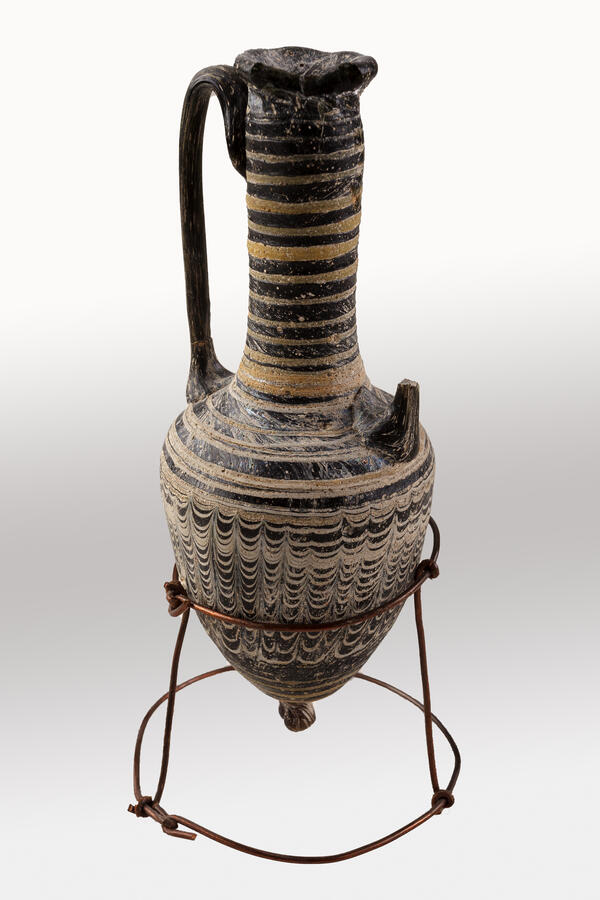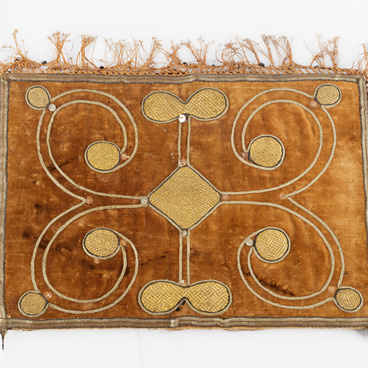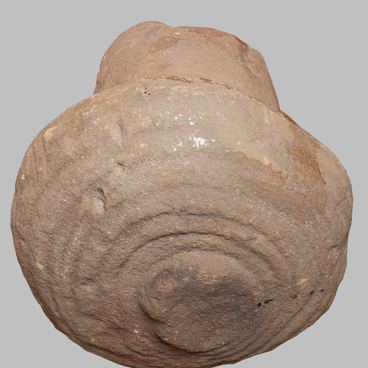The museum collection includes a glass amphoriskos, which was found on October 24, 1950 near the Falshivy Gelendzhik village (now the village of Divnomorskoye) by a school teacher P.V. Semenov.
The vessel got its name because it resembled the amphora. An amphora is a vessel with a wide body that tapers downwards, a narrow neck and two vertical handles. The ancient Greek word “amphora” is translated as “carried from both sides”. Amphorae were usually made from clay, but there were also bronze, silver, marble, and glass samples. An amphora could hold from 5 to 50 liters. Amphorae were used as storage and transport vessels, tableware and ceremonial objects. These large jars were used to transport wine and olive oil. They could also be used as burial urns. An amphoriskos is a “small amphora”, used for perfume or toilet oil.
The amphoriskos displayed in the museum is made using the sand-core technique, and decorated with yellow and white glass threads. Modern scientists revived this glassmaking technique. An iron rod was inserted into the core — a small bag made of sand and clay. Small amounts of molten glass that had been prepared in advance were trailed onto the core, while the glass was constantly heated in the furnace. When the shell was completed and acquired a certain thickness, the surface was marvered to make it smooth. Later, thin colored threads were applied to the slightly cooled vessel, forming a pattern. After complete cooling, sand and clay were removed. This procedure resulted in a high percentage of defects. Ancient glass blowers were not skilled enough to produce such glassware galore, and glass products remained a symbol of luxury and prosperity, inaccessible to an ordinary person for a long time. Absolutely transparent and pure glass products were a rare occurrence, and antique glass was mostly colored, having varying degrees of transparency.
The vessel got its name because it resembled the amphora. An amphora is a vessel with a wide body that tapers downwards, a narrow neck and two vertical handles. The ancient Greek word “amphora” is translated as “carried from both sides”. Amphorae were usually made from clay, but there were also bronze, silver, marble, and glass samples. An amphora could hold from 5 to 50 liters. Amphorae were used as storage and transport vessels, tableware and ceremonial objects. These large jars were used to transport wine and olive oil. They could also be used as burial urns. An amphoriskos is a “small amphora”, used for perfume or toilet oil.
The amphoriskos displayed in the museum is made using the sand-core technique, and decorated with yellow and white glass threads. Modern scientists revived this glassmaking technique. An iron rod was inserted into the core — a small bag made of sand and clay. Small amounts of molten glass that had been prepared in advance were trailed onto the core, while the glass was constantly heated in the furnace. When the shell was completed and acquired a certain thickness, the surface was marvered to make it smooth. Later, thin colored threads were applied to the slightly cooled vessel, forming a pattern. After complete cooling, sand and clay were removed. This procedure resulted in a high percentage of defects. Ancient glass blowers were not skilled enough to produce such glassware galore, and glass products remained a symbol of luxury and prosperity, inaccessible to an ordinary person for a long time. Absolutely transparent and pure glass products were a rare occurrence, and antique glass was mostly colored, having varying degrees of transparency.




